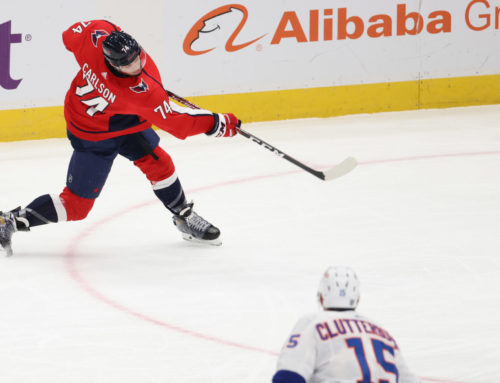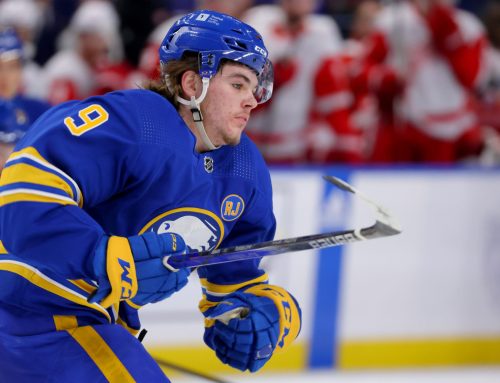June 21, 2014
Darren Kennedy
2014-06-21
Brad Richards has come to symbolize what is, at least to me, a pretty significant issue with NHL unrestricted free agency. He's not the first, nor likely the last, player to receive a hugely lucrative contract at a time in his career when he had little or no chance of performing at a level even approaching his compensation. It's a problem that isn't going away anytime soon (unless we're willing to sit through another prolonged work stoppage – we aren't)
The primary ways in which star players become unrestricted is by turning 27 before June 30th of a particular year or after completing seven full seasons. Thus allowing them to swim in the money filled waters that are free agency.
In theory this should mean that players are coming into their prime right as they're free to pick a destination of their choosing. Instead, as a result of bridge deals and longer second and third contracts, we have a number of players reaching free agency in their late twenties and early thirties. For example, Brad Richards was 31 when he signed a nine year, $60 million dollar contract with New York. Even if we assume retirement was going to take place around 2017 (when his annual salary dipped to $1million) that still left him with a cap hit of $6.7 million until the age of 37.
Some guys are capable of playing productively into their late thirties. We don't have to look further than Teemu Selanne (although I'm not convinced he isn't some sort of Terminator-like cyborg) and Martin St.Louis for recent examples of that. But there are also plenty of guys who either breakdown or decline well before what should be their golden years – players like Markus Naslund, Peter Forsberg, or Pavel Bure.
UFA contracts are, by definition, contracts that the other 29 teams thought were batshit crazy. If they didn't feel that way they would have offered more. With players signing these massive, long-term deals only a couple of years before their decline sets in we're being left with a league of once-upon-a-time stars clogging up cap sheets everywhere. This time around owners were bailed out by the compliance buyout provision. Four, five, six years into the future, when there is no safety net, teams will be saddled with a number of onerous deals to players in their mid-thirties. Owners are simply incapable of helping themselves from, well, themselves.
*
That was a long opening ramble. I'm trying to keep up with Rick Roos – dude can flat out write.
*turns hat backwards – gets to work*
*
I'm getting older, but I'm not THAT old. In my 15 or so years of watching hockey I can't remember a time when this many legitimate top six centermen were on the market at one time. The list is absolutely staggering; Kesler, Thornton, Spezza, Cammalleri (if you choose to play him there), and Stastny are just a few of elite options available. That's not to mention the crop of solid supporting options, guys like Grabovski, Legwand, Richards (as of yesterday), Roy, and Jokinen.
(Notice that I left Bolland off of this list – I'm secretly hoping that Nonis is a regular Dobber reader)
The fantasy impact of all these guys, assuming most of them move, is astronomical. Take Thornton for example, everywhere he goes he drags his line-mates production skyward. If he lands in somewhere like Chicago or even Toronto the change in their top six and power play until will affect the fantasy fate of many. If Grabovski remains in Washington he'll take on a key second or third line role that will alleviate Ovechkin, Backstrom, and Kuznetsov from a number of tough minutes, freeing them up offensively. Cammalleri scored at a near 40 goal pace last season. If he lands alongside the right centerman he could alter production by as much as seven to 10 points.
If I own any of the above assets in a dynasty league I'm waiting until well after July 1st before making any long-term decisions.
*
I've written before that Columbus' Ryan Johansen worries me. His 33 goals, 30 assists, and 237 shots was impressive for a guy who has not yet turned 22. However, those numbers were buoyed in large part by a shooting percentage of 13.9% (likely unsustainable). Additionally, he has been receiving a tonne of praise in the media from just about everyone. When you mix those two things together there is a real chance a player becomes overvaulted at the draft table.
That's what I thought, anyway. After doing a bit of digging around ExtraSkater.com I came across his teammates shooting percentage with him on the ice – it was only 5.7% last year – lowest on the Blue Jackets. To help put that in perspective Nathan MacKinnon's teammates shot at 10.4%.
Even if we assume, rightly, that Johansen will regress a tad when it comes to his own goal scoring it's unlikely his line-mates are going to be nearly as inept again next year. Assuming both of these facts come close to evening out (I'm no mathematician but this seems reasonable), I'm now a lot more confident that last season's production is repeatable.
*
Blueshirt Banter with some notes Brad Richards and his buyout. I found it especially interesting to read through the fan comments below.
*
Puck Daddy asked a fair question in "Is this the end for Saku Koivu?"
“I don’t know if he’s going to retire or not but I know he went home to think about it,” Murray said, via the Times. “I just felt we had younger players coming along that we had to move into the lineup. I thought it was best for this organization that we move forward a little bit.
Fantasy-wise it has been some time since Koivu was overly relevant. Lately he has been relegated to the short-term waiver grab pile, a guy you target when in need of some last minute production on Saturday or Sunday. Even so, if this is in fact the end of his NHL days, we would be remiss not to acknowledge his early career success. Between 2002 and 2007 he twice broke 70 points and had become a legitimate top 50 option in point's leagues. At his peak there weren't many guys more fun to watch or cheer for. He will be missed.
*
These Evander Kane for Nail Yakupov trade rumors have been making the rounds across multiple outlets. The kid in me absolutely wants this to happen. It's the kind of deal you make in NHL 14, along with shipping Crosby to Toronto, Lundqvist to Chicago, and Bozak to the ECHL – it's fun to think about. In this case, though, I feel like there are too many barriers in place.
Kane is signed on an immensely cap friendly deal in Winnipeg – $5.25 million per year through 2018. In a market that will undoubtedly have a hard time luring in high priced free agents (it's damn cold up there) I don't expect them to trade away a star player on a manageable contract. Bringing in Yakupov would pose significant risk, in that he isn't as far along the developmental curve as Kane and there is always the undercurrent of KHL rumors (although by most indications Yakupov enjoys the North American game and won't be leaving anytime soon).
From Edmonton's side this deal would be tricky. Sure, Kane is a better player today, but Yakpov is only entering year three and likely has a higher offensive ceiling. They would assuredly be asked to add something of value to the deal (maybe Gagner), increasing their risk if Kane didn't work out.
I hope to be proven wrong on this one (principally because I have both in a dynasty
league) but too much needs to line up for it to come to fruition.
*
One storyline that seems to be flying under the radar is that Jarome Iginla remains unsigned by Boston. It appears that both sides are interested in finding a middle ground. If they don't, it will certainly change a lot of things on July 1st, with the former Flame providing a shorter term wing solution for teams that may be scared away from the big money demands of Vanek, Gaborik, and Moulson.
For those wondering, Iginla (soon to be 37) is still pretty good at this whole hockey thing…
Darren Kennedy is a contributor for Dobber Hockey and Mckeen's. You can find him on twitter @fantasyhockeydk





 TOR
TOR S.J
S.J ANA
ANA EDM
EDM CAR
CAR DET
DET CGY
CGY VAN
VAN BOS
BOS COL
COL
